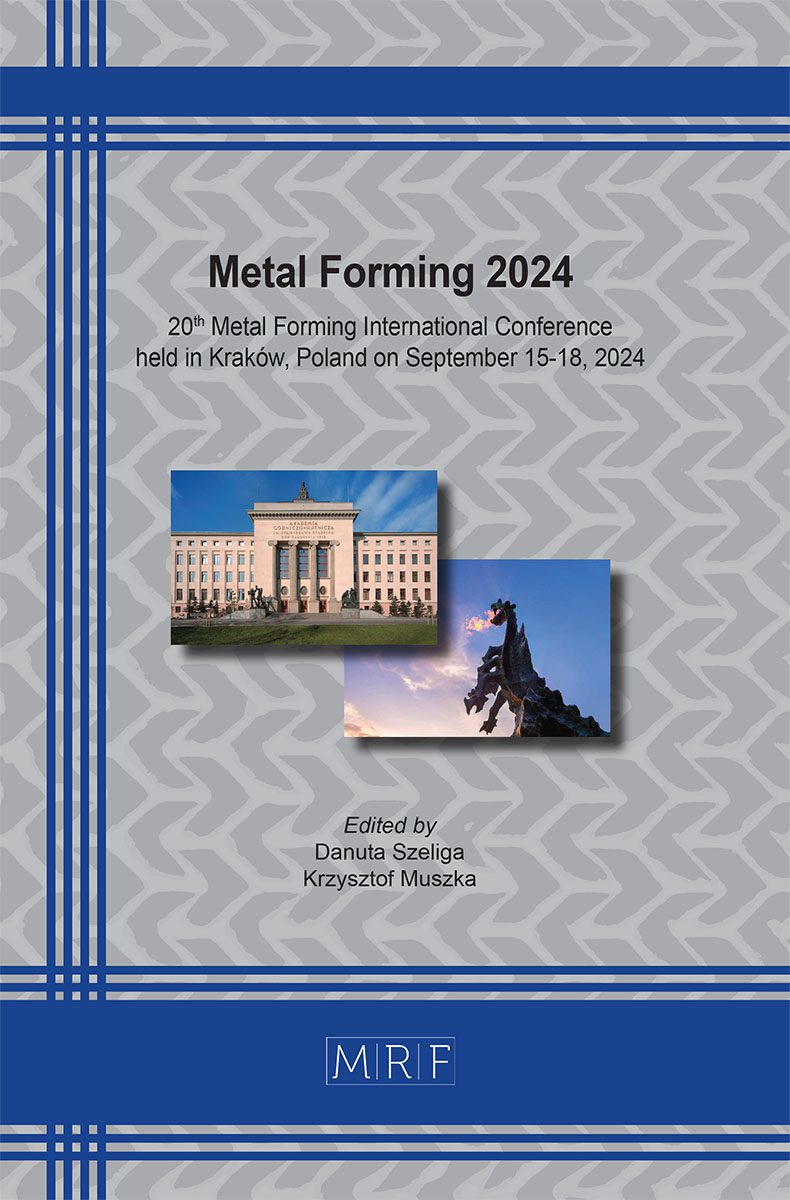–
Plastic flow modelling under abrupt strain-path change and parameter identification method
ZHANG Tianyin, HAN Xianhong
download PDFAbstract. Rational plastic flow modelling under abrupt strain-path change is crucial for accurate metal forming simulations. Previous experimental studies have revealed that many metals exhibit “corner effects” after abrupt strain-path change in the plastic stage, including a sharp vertex produced on the subsequent yield surface and apparent non-normality of the plastic flow direction. Some advanced models can give reasonable predictions on the above phenomenon, but they have not been widely used in metal forming simulations due to their complexity. A simple non-associated flow rule is developed here to describe corner effects. A stable stress update algorithm is developed for this rule based on the fully implicit backward Euler method, and its validation is verified by FE simulations of the nonlinear tension-torsion loading experiments. In order to determine the material parameters of these non-associated flow rules representing corner effects, a general identification method is proposed based on the equivalent tangential shear modulus reduction. The results show that, compared with the previous theories, the present rule performs better in predicting corner effects. In addition, although the apparent tangential shear modulus reduction is observed during the nonlinear experiments, the modulus does not seem to decrease to near zero.
Keywords
Plastic Flow Rule, Corner Effects, Strain-Path Change, Parameter Identification
Published online 9/15/2024, 6 pages
Copyright © 2024 by the author(s)
Published under license by Materials Research Forum LLC., Millersville PA, USA
Citation: ZHANG Tianyin, HAN Xianhong, Plastic flow modelling under abrupt strain-path change and parameter identification method, Materials Research Proceedings, Vol. 44, pp 100-105, 2024
DOI: https://doi.org/10.21741/9781644903254-11
The article was published as article 11 of the book Metal Forming 2024
![]() Content from this work may be used under the terms of the Creative Commons Attribution 3.0 license. Any further distribution of this work must maintain attribution to the author(s) and the title of the work, journal citation and DOI.
Content from this work may be used under the terms of the Creative Commons Attribution 3.0 license. Any further distribution of this work must maintain attribution to the author(s) and the title of the work, journal citation and DOI.
References
[1] T. Kuwabara, M. Kuroda, V. Tvergaard, K. Nomura, Use of abrupt strain path change for determining subsequent yield surface: Experimental study with metal sheets, Acta Mater. 48 (2000) 2071-2079. https://doi.org/10.1016/S1359-6454(00)00048-3
[2] K. Yoshida, T. Tsuchimoto, Plastic flow of thin-walled tubes under nonlinear tension-torsion loading paths and an improved pseudo-corner model, Int. J. Plast. 104 (2018) 214-229. https://doi.org/10.1016/j.ijplas.2018.02.013
[3] K. Yoshida, N. Okada, Plastic flow behavior of fcc polycrystal subjected to nonlinear loadings over large strain range, Int. J. Plast. 127 (2020) 102639.
[4] T.Y. Zhang, X.H. Han, Parameter identification for the non-associated flow rules representing corner effects through the equivalent tangential shear modulus reduction after abrupt strain-path change, Int. J. Plast. 169 (2023) 103726.
[5] L. Ronning, O.S. Hopperstad, P.K. Larsen, Numerical study of the effects of constitutive models on plastic buckling of plate elements, Eur. J. Mech. A Solids 29 (2010) 508-522. https://doi.org/10.1016/j.euromechsol.2010.02.001
[6] A. Nasikas, S.A. Karamanos, S.A. Papanicolopulos, A framework for formulating and implementing non-associative plasticity models for shell buckling computations, Int. J. Solids Struct. 257 (2022) 111508. https://doi.org/10.1016/j.ijsolstr.2022.111508
[7] K. Yoshida, A plastic flow rule representing corner effects predicted by rate-independent crystal plasticity, Int. J. Solids Struct. 120 (2017) 213-225. https://doi.org/10.1016/j.ijsolstr.2017.05.004
[8] M. Kuroda, V. Tvergaard, Shear band development in anisotropic bent specimens, Eur. J. Mech. A Solids 23 (2004) 811-821. https://doi.org/10.1016/j.euromechsol.2004.05.006
[9] K. Ito, K. Satoh, M. Goya, T. Yoshida, Prediction of limit strain in sheet metal-forming processes by 3D analysis of localized necking, Int. J. Mech. Sci. 42 (2000) 2233-2248. https://doi.org/10.1016/S0020-7403(00)00004-7
[10] M. Kuroda, V. Tvergaard, A phenomenological plasticity model with non-normality effects representing observations in crystal plasticity, J. Mech. Phys. Solids 49 (2001) 1239-1263. https://doi.org/10.1016/S0022-5096(00)00080-6
[11] Y.F. Yang, T. Balan, Prediction of the yield surface evolution and some apparent non-normality effects after abrupt strain-path change using classical plasticity, Int. J. Plast. 119 (2019) 331-343. https://doi.org/10.1016/j.ijplas.2019.04.006
[12] J.C. Simo, A J2-flow theory exhibiting a corner-like effect and suitable for large-scale computation, Comput. Method Appl. Mech. Eng. 62 (1987) 169-194. https://doi.org/10.1016/0045-7825(87)90022-3
[13] T.Y. Zhang, M.S. Liu, X.H. Han, A non-associated flow rule with simple non-branching form representing the apparent non-normality effects after abrupt strain-path change, Int. J. Plast. 159 (2022) 103452. https://doi.org/10.1016/j.ijplas.2022.103452












